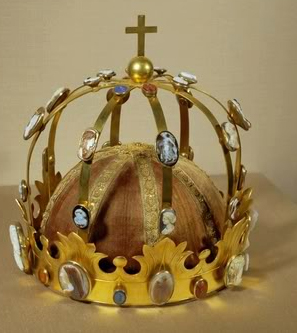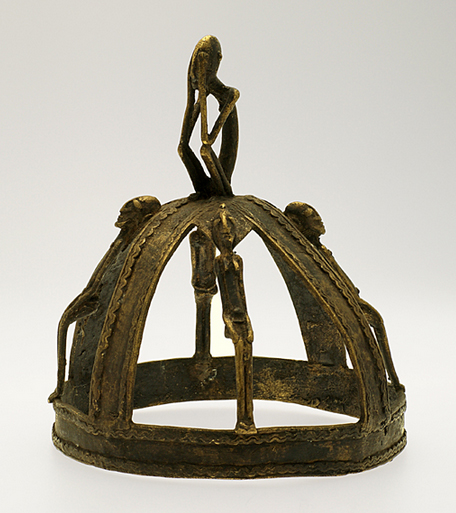I believe Diana Scarisbrick put Charlemagne’s original crown on the cover of her book, Royal Jewels: From Charlemagne to the Romanovs

A Carolus Magnus-style crown was also made in 1804 for Napoleon’s coronation.

What I like about Napoleon’s version is that the design resembles a Dogon crown in The Creative Museum. Its theme is the honor of ancestors, as the chief sits atop and remembers.
The Dogon people live in the central plateau region of Mali, south of the Niger River in West Africa.
Heavily involved in the slave trade, the French had established strong presence on the West African coast as early as 1659. Their port was in St. Louis, or present-day Senegal. If you look on a map, Senegal is but a few miles away from Mopti, Mali, home of the Dogon.
Do the crowns allow us to connect the dots?

Though those first two crowns are incredible works of the jeweler’s art, it is still that Dogon crown that is stunning in its emotional impact.
The depiction of such tender, vulnerable humanity moves you in a way, makes a connection, the other two do not. Incredible.
It’s similar to the Gilbert Mair / Pataromu Tamatea story, isn’t it? Mair eliminated Tamatea’s name from museum immortality after buying his masterpieces for very little.
However, this hypocrisy goes way beyond that. As Europeans were committing genocide on West Africans by stripping them of their names, languages, cultures, and transporting them to America on death ships, they were also African art connoisseurs.
Think about this.
When European and American artists saw Japanese Edo combs for the first time at the Paris Exposition Universelle in 1867, they flipped, created Art Nouveau, threw in a dash of Symbolism, and Japonisme was born. That transfer of ideas occurred because trade routes opened up as Meiji Emperors took power in Japan.
During the Colonial slave trade, a trade route opened up from Africa to the United States. Murderous racism allowed white merchants to recognize that tribal designs were worth stealing while they destroyed the identites of the artists who created them.
And you find the evidence in royal crowns? Amazing.